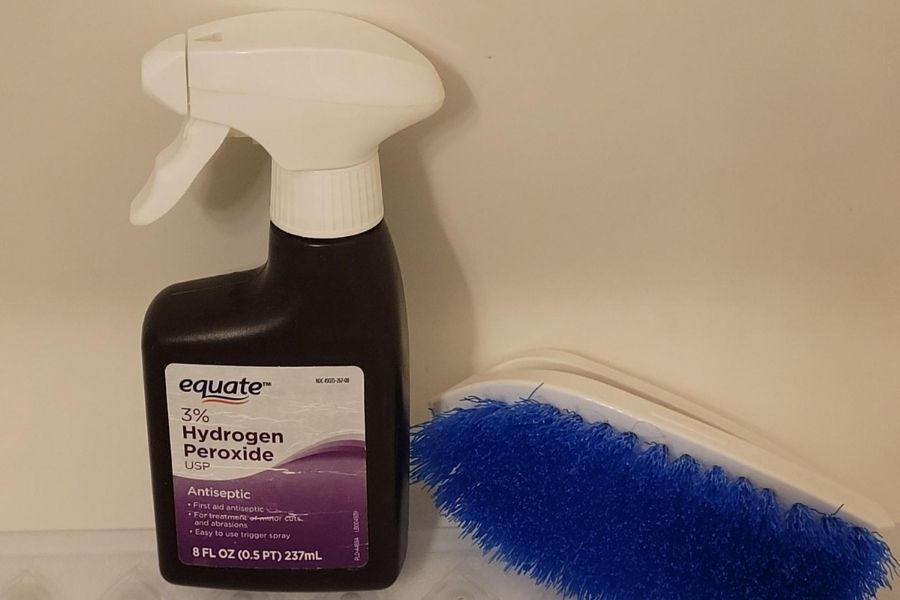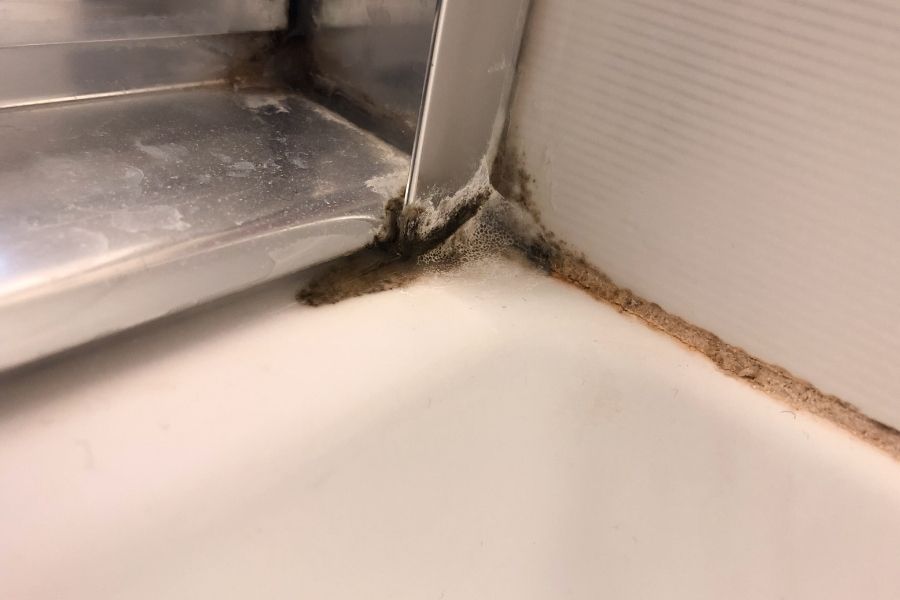Caulk is a great way to seal gaps in showers, but it’s not without faults. Eventually, it will degrade, although mold is the most common problem any homeowner will encounter.
That leaves many people wondering how to remove mold from shower caulking, which can lead to a variety of answers.
Removing black mold from shower caulk is easier than you think. In fact, you probably already have things in your home that will clean mold and mildew from shower caulking.
Whether you have a tiled shower with moldy shower caulk in a few areas or a full-blown infestation, our guide will tell you how to fix it.
We’re also going to discuss ways to prevent mold from reoccurring, so you can spend more time enjoying your shower instead of cleaning it.
Causes of Mold on Shower Caulk
You can find mold and mildew inside homes in places like bathrooms, kitchens, and basements. Mold can find a foothold in any moist environment, making showers the perfect place for this troublesome fungus.
Mold is the fungus family and requires moisture and food to grow. It gets the latter from grime and soap scum that builds up on shower surfaces, including caulk. These tiny spores can spread with ease in a bathroom and grow quickly when left unchecked.
Bathrooms with poor ventilation are a prime target for mold. While unsightly when it begins to grow, it can also pose health problems.
Mold and Health Issues
The most common type of mold found on shower caulking is black mold, but you may have also noticed a pink substance on caulk in a shower or on shower walls.
Both can be harmful to your health, although that pink slime isn’t actually mold at all.
If you see pink on caulking, that usually indicates a bacterium called Serratia marcescens. This bacteria feeds on soap scum in damp bathrooms and isn’t as harmful as the black mold.
It can pose health issues if it gets into an open cut or to people with pre-existing conditions, however.
Black mold is nastier and a common cause of allergies when present in a home. It can cause sneezing or red eyes in healthy individuals with prolonged exposure but is far more harmful to anyone with a repository condition.
How To Remove Mold From Shower Caulking
Before attempting to remove mold from a shower, you’ll want to round up some supplies. Most of these items are found around the home and you can substitute a toothbrush with a sponge or even cotton balls.
When using any of these methods to remove mold from shower caulk, always clean the caulk in a shower from top to bottom.
Failure to do so could result in the contamination of areas you’ve already cleaned. To combat any errant black mold spores, you should also clean the surrounding shower area and wipe them down with bleach or Clorox wipes.
Supplies:
- Bleach
- Vinegar
- Hydrogen Peroxide
- Baking Soda
- Rubber Gloves
- Spray Bottle
- Bucket
- Toothbrush or sponge
Method 1: Bleach
Bleach is a proven disinfectant that can remove stains from clothing, sanitize surfaces, and even help flowers last a bit longer. It will also remove mold and mildew.
Step 1 – Open any windows and doors or turn on a fan in the bathroom where you plan to clean.
Bleach can irritate the skin, eyes, and nose, so ventilation is essential. Put on the rubber gloves, and then get the bleach.
Step 2 – Mix bleach solution in a bucket using 1 cup of bleach for 1 gallon of water. Cut the mixture down as needed if you’re using a smaller container.
Step 3 – If you plan on using a spray bottle to clean shower caulk, fill it and spray down any mold on the caulking. You don’t need to soak it but should apply it thoroughly.
When using a sponge, soak the sponge in the bucket with the bleach mixture and wipe the moldy areas down as needed. If using a dual-sided sponge, use the soft side – not the scrubber.
Step 4 – Let the bleach sit on the moldy areas for at least 20 minutes. Afterward, you can rinse the bleach away and scrub any stubborn spots with an old toothbrush or clean sponge.
Method 2: Vinegar
Vinegar is another substance mold hates, and while it can be noxious, it’s highly effective on caulked areas with black mold growth.
Step 1 – Take the vinegar and dilute it into a 1:1 mixture. While you can use a bucket, we highly recommend a spray bottle.
Step 2 – Spray the affected areas with the white vinegar mixture. Leave the room to let it air out and let the vinegar work for around an hour.
Step 3 – Rinse the areas with warm water and scrub away any mold using a soft-bristled toothbrush or sponge.
Method 3: Hydrogen Peroxide
If you’ve ever had a cut, you have probably experienced the wonders of hydrogen peroxide. It’s usually found in medicine cabinets, and has far more uses than cleaning a dirty cut.
It’s more soothing than alcohol on a wound and annihilates mold by breaking down its molecular structure.
You can use peroxide as you would with a cut by soaking cotton balls, a paper towel or rag. Make sure wherever you choose is properly saturated before wiping down the mold.
Make sure it’s at least 3% hydrogen peroxide, and let it sit for 10-20 minutes before giving it a scrub. An easier way is to use a spray bottle of hydrogen peroxide like the one you see below.

Alternatively, several companies sell hydrogen peroxide mold cleaners designed to kill more than 40 types of bacteria and viruses.
Method 4: Baking Soda
We’ve talked about how effective baking soda is at clearing clogged drains. It can also kill mold and is the “greenest” method to make our list. It doesn’t leave any foul odors behind, and is useful for cleaning a variety of things in kitchens and bathrooms.
For this method, put the spray bottle aside and mix up a paste using baking soda and water. You can start with a ¼ teaspoon, but there’s no perfect amount.
Ideally, you want to aim for a consistency similar to toothpaste. This allows the mixture to stay in place in vertical surfaces while providing more texture for scrubbing.
Apply this mixture to any shower caulk with mold growth using a toothbrush. After a scrub and rinse, the molded caulk should look good as new.

How To Prevent Mold From Growing on Caulk
Once you’ve removed black mold from the shower caulking in a bathroom, it’s time to make sure it doesn’t come back.
While you can’t completely eliminate it from a moist bathroom without routine cleaning, you can take steps to slow down its progress.
A lot of homeowners close the bathroom door after a shower. It may keep pets and children out of the room, but it also allows mold to grow.
Opening the door and the curtain or shower afterward allows the area to dry out. You can also turn on a bathroom fan in the bathroom to help vent excess heat and moisture. Drying off shower walls and other surfaces prone to mold will also help.
Wiping the shower caulk down with vinegar once every few weeks might be smelly, but it will inhibit mold growth.
There are several cleaning solutions designed to “block” mold as well – just make sure they are safe for caulk and surrounding surfaces.
The Bottom Line
Bleach is the best way to get rid of mold on caulk and disinfect an area, while vinegar provides a more natural approach.
Any of our methods will work, but you should also keep the condition of the caulk in mind.
If the shower caulk is worn or mold continues to return, it could be growing beneath the caulk itself. In this case, you’ll need to remove it and caulk those areas again.
FAQ
What’s the Best Type of Caulk To Use in a Shower?
A high-quality silicone caulking that’s designed specifically for showers.
Can You Caulk Over Mold in a Shower?
While you can caulk over caulk when properly cleaned or fill gaps, doing so over mold is a temporary solution. The mold will continue to grow, so remove mold before caulking.
Will a Spray Bottle With Ammonia Kill Mold?
Yes, ammonia will destroy mold and mold spores in around 30 minutes but not preferred when other options are available.
You should also never mix any amount of ammonia with bleach because it creates toxic fumes.
What Happens if You Shower With Mold on the Caulking?
Moldy caulk spores in the shower could become airborne and inhaled, causing respiratory issues with a wide range of symptoms.
Can I Use Apple Cider Vinegar Instead of White Vinegar To Clean Moldy Caulking?
Yes, it has the same properties as regular vinegar but without an unpleasant smell.
